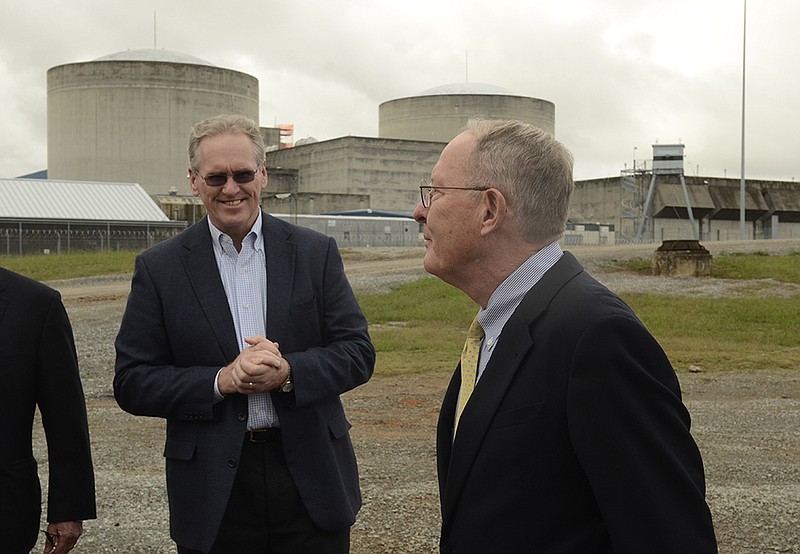Over the weekend, three electricity stories should have jumped out at readers, though only one of them was on a prominent news page.
The headline on Page 2 of Saturday's business section stated "TVA says tritium releases rise within nuclear plant." A headline on the next page, same day, read "Alexander wants more nuclear power." Then, on Sunday's Business section front came a story headlined "Electricity demand flat."
It would be nice to be able to say that, beyond the headlines, the summary is pretty simple: TVA's Watts Bar Nuclear Plant in Rhea County is on a path to make more releases of radioactive tritium than prescribed limits but still wants to make more. Meanwhile our state's senior U.S. senator, who loves nuclear power, wants more nuclear power. And never mind that our need of power is continually decreasing with appliance efficiency, so TVA power sales are flat.
But nothing with TVA, nuclear power or Sen. Lamar Alexander is ever simple. And no one or no thing should ever lull us to think otherwise.
If you read beyond the headlines of those stories, you'll learn the Tennessee Valley Authority -- our public utility which uses water, coal, gas, three nuclear plants (one in Hamilton County) and a small wind farm in upper East East Tennessee -- has problems on a couple of fronts.
TVA makes electricity for us and people in seven states, but it also makes weapons-grade tritium for the U.S. government at its Watts Bar Nuclear Plant, which is on the Tennessee River just below the Watts Bar Dam and upstream of Chattanooga. TVA and the Department of Energy want to boost that production, even though what the plant now makes is already expected to raise tritium levels within the plant above its prescribed limits sometime later in this year -- even before the utility's board decides whether to more than double that production of radioactive material.
TVA says the elevated levels of the radiated water within the plant presents no problems. Why then are the plant's prescribed limits lower?
To make the weapons-grade tritium, TVA installs special rods from DOE, along with regular uranium rods, into the reactor core of the Watts Bar Unit 1 reactor during each fuel cycle.
Weapons-grade tritium has a half life of 12.5 years, meaning that the substance has to be replaced on a regular basis to maintain the power of America's nuclear warheads. The fiscal 2016 budget of the National Nuclear Security Administration, an arm of the U.S. Department of Energy, calls for TVA to increase tritium-making.
There are plenty of nuclear experts who think this is a bad idea. One of them is David Lochbaum, director of the Nuclear Safety Project for the Union of Concerned Scientists.
Aside from the obvious problems of enhanced radioactive risks, there also is the need and cost of additional security, as well as transport threats and increased potential for terrorist targeting.
"It's like taking a gun aimed at our enemies and putting it against our own heads," Lochbaum said. "As TVA's letter points out, they are taking steps to prevent the trigger from being pulled. ... Of course, smart people wouldn't put loaded guns to their heads and hope they don't go off."
And shouldn't DOE's emphasis be charting a reduction in the need of tritium due to weapons dismantlement already legally mandated by the Nuclear Nonproliferation Treaty?
Then there's the question of Alexander's notion that we need more nuclear plants, even while he continues his assault on tax credits for wind energy.
"Relying on wind when nuclear plants are available is the equivalent of going to war in sailboats when nuclear ships are available," Alexander said in a speech at the Nuclear Energy Institute.
Hardly. Alexander just likes nuclear power -- and the support he has received over the years from the nuclear industry.
He continues to push (and TVA continues to study) the possibility of adding small modular reactors in Oak Ridge under a pilot program with the U.S. Department of Energy. Price tag? $900 million per unit. TVA continues to maintain its unfinished Bellefonte Nuclear Plant in Hollywood, Ala., for potential future use. Price tag? Some $6 billion and counting.
Finally, just what part of tax credits for solar and wind energy are a problem?
In cumulative dollar amounts, over the lifetimes of their respective subsidies, the oil, coal, gas and nuclear industries have received about $630 billion in U.S. government subsidies, while wind, solar, biofuels and other renewable sectors have received a total of roughly $50 billion in government investments, according to DBL Investors.
There's a bigger picture to our energy needs, and we need to look at the whole landscape.
